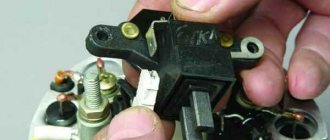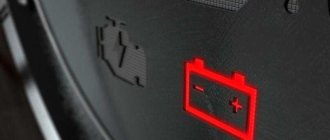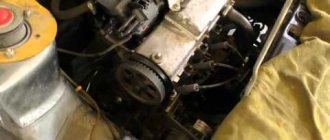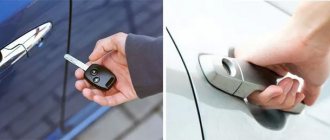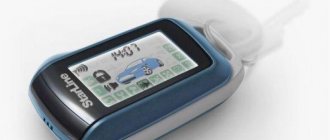Even in central Russia, frosty nights are not uncommon in winter. What to do when the electrolyte in the battery freezes in winter? The device is not always hopelessly damaged. At the beginning, when the liquid is not completely frozen, it is still possible to save the battery from deformation caused by an increase in the volume of ice. Every car enthusiast should know the reasons for electrolyte freezing, preventing the problem and methods for resuscitating the battery.
The electrolyte in the battery is frozen, what should I do?
The most unpleasant thing that can await a car owner on a winter morning is that the door to the interior does not open and the car does not start. It turns out that the electrolyte in the battery froze and it died. This happens when the battery charge is low. If the car is left in the evening with a low battery charge, which will run out overnight, expect trouble.
Signs that the battery is frozen are convex walls of the case covered with frost. What to do if the battery in your car freezes in the cold? To achieve complete freezing of the cans, you need to try:
- leave a discharged old battery in the cold for a day or more;
- create a large current leak in the circuit, which will cause even a new battery to freeze, bringing the charge to zero;
- ensure long-term downtime of the car with the battery in the cold.
The batteries are designed to operate at temperatures from +60 to – 40 degrees, but the conditions on which the battery’s performance depends must be met. What to do if there is an accident and the battery freezes? The biggest mistake is connecting the device to the charger immediately. It is possible that internal deformation of the plates and separator has occurred, and cracks have appeared in the housing. It all depends to what extent the electrolyte in the car battery is frozen.
Sequencing:
- remove the battery from the car;
- carry out an external inspection for cracks and leaks;
- place the battery in an enamel bowl and leave until the ice melts, the sides “deflate”, and the frost on the case disappears;
- If there are no obvious signs of deformation of the frozen battery, it can be charged according to a special schedule.
First you need to make sure with a litmus test that the moisture on the case is harmless. Has the indicator strip turned red? Microcracks may be invisible to the eye, but the electrolyte will find them. If the battery has caps, take a sample of the electrolyte for transparency.
If for some reason a frozen battery needs to be quickly revived, how to charge it? In order to speed up the melting, you can turn on the heat gun, but you cannot immediately place a frozen battery in hot water. You can place the case in a cool environment and raise the temperature by gradually adding water. This should be done in enamel dishes and protective clothing.
We suggest watching a video where a specialist explains what to do if the battery is frozen.
Gray or black electrolyte is bad!
Let's say you defrosted the battery, but when you looked at the cans (battery compartments), it or two took on a black or thick gray color. I want to say right away, go get a new battery, what does this tell us, but nothing good:
When the water froze, it damaged the lead plates and simply destroyed them, or, if you like, tore them. After the electrolyte has defrosted and turned back into liquid, these compartments no longer have structured plates, but simply a bunch of lead that was mixed in the jar, which is why it became cloudy. Even if one bank fails, the voltage will drop by 2 Volts, that is, the nominal value will be 12 and 10 Volts. Such a battery will not be able to start your car, and what can it start, it is not even able to “soak” the car’s systems (radio, ECU, dashboard, etc.). This is the “death” of the battery.
Of course, many manage to restore this jar by cutting the top and pulling out - restoring the package of lead plates. But for an ordinary car enthusiast, this is very difficult and almost impossible. Let's go get a new battery.
Can the electrolyte in the battery freeze?
Pure water freezes at 0 0 C. In solutions of salts and acids, the freezing point depends on the concentration and type of substance. Batteries use a sulfuric acid solution as an electrolyte. The accumulation of energy in the elements and at what temperature the liquid freezes depends on its concentration.
In order for the water in the battery to freeze to the state of a monolithic piece of ice, it must be completely discharged and cooled to ambient temperature. The expanding ice will tear the body, the cans will swell, the plates will bend. Is it possible to charge a deeply frozen battery? No. A deformed device is only suitable for disposal.
What does the battery consist of?
I’ve talked about it a thousand times already on the blog (for those who want to educate themselves, read the article - how a battery works , it’s really laid out “at your fingertips”). BUT I will repeat, briefly, to understand the map of the incident. The main elements are:
Housing - made of six sealed compartments (usually made of plastic so that it does not react with acid).
The plates are negative and positive (made of lead and its dioxide, respectively).
Electrolyte is a special conductive liquid made from sulfuric acid + distilled water . Without it, the battery would not work.
The plates are immersed in a housing and filled with electrolyte, which is exactly what a regular lead-acid battery is. The more lead and liquid inside, the larger its capacity.
Got it, let's move on.
Why does the battery freeze in winter?
In any battery there is a continuous redox reaction. When the device is discharged, an insoluble precipitate of lead sulfate settles on its plates. And then the electrolyte becomes less concentrated. If this happens in winter, conditions arise for the electrolyte in the battery to freeze. That is why for the winter they install a new battery, without signs of sulfation, and monitor the charge level. The proposed table actually shows the condition of the device, depending on the density of the electrolyte
More and more motorists are using disposable calcium batteries. Their tightness does not allow checking the condition of the electrolyte. This means that control should be carried out using open circuit voltage. If the jars in a calcium battery are frozen, it should be thawed in gentle conditions, recharged and tested. Often such a device is not restored.
Physico-chemical processes always occur within the designated parameters. If the car battery is frozen, it means that the operating conditions have been violated. Why does the electrolyte freeze - its concentration is below the point of crystal formation. The battery freezes in winter, since in summer the ambient temperature is greater than -7 0, the lowest electrolyte concentration, corresponding to a density of 1.11 g/cm3. Can the battery freeze in spring or fall? Maybe if you create the appropriate conditions for the destruction of the device.
What causes freezing
Now you need to find out why the electrolyte freezes in the battery and what provokes such phenomena.
As you know, an electrolyte is a mixture of sulfuric acid and distilled water. Ready-made solutions usually have a density of 1.27–1.28 g/cm³. This is the optimal indicator for most operating conditions.
Although in the northern regions, where extremely low temperatures are observed, the density can be increased even to 1.3 g/cm³. But at the same time, the battery life is significantly reduced, and it can withstand about 1 year of operation.
If the density is correct and the workmanship is high, then freezing is possible only at -70 degrees Celsius. When a deviation from the optimal parameters occurs, the temperature threshold decreases.
There are several reasons why the electrolyte poured into the battery freezes and causes corresponding problems in the car. This can happen in winter when temperatures drop below zero. The following reasons provoke freezing:
- initially low-quality electrolyte;
- frequent additions of distilled water to the battery;
- a significant reduction in the recommended density;
- severe battery drain.
Density changes under the influence of various factors. An increase in these values is usually observed, which is due to the gradual evaporation of the water component of the mixture. The acid cannot evaporate. There is less water and more acid, which leads to an increase in density.
As for situations when the electrolyte loses its density and conditions are created in the battery for its freezing, then the reason lies in electrolyte leaks and depressurization.
Prolonged downtime of the car provokes gradual self-discharge. The newer the battery, the longer it is able to maintain its characteristics. If the power source is worn out, the battery is stored in conditions of low temperatures and high humidity, then the density will drop and the charge will decrease. When critical values are reached, freezing occurs.
Charging a frozen battery
After the water that froze inside the battery case has melted, no visible deformations or leaks have been detected, it needs to be reanimated. At the same time, gentle conditions are observed.
How should you charge a frozen car battery? Experts advise using only an automatic charger. It is this tool that can provide a full battery charge. At the first stage, a pulsed current is used, which will remove sulfate deposits from the plates. The main charging is carried out carefully, using 5% of the charging current of the battery capacity. So, a 60 A battery should be recharged with a current of 3 A for 8-10 hours. Subsequently, the current is further reduced, and charging is brought to the norm of 12.6 V.
If possible, you need to make sure that the electrolyte is transparent, with no signs of shedding of the plates. A cloudy liquid indicates the presence of internal changes. A short circuit is possible in the banks, the plates fall off. The battery is not suitable for further use.
You should not overcharge a battery that has just frozen. In the future, in the cold, the battery can create new problems; it is suitable for summer use.
What can electrolyte freeze up cause?
When the electrolyte freezes, a significant increase in its volume occurs, which, in conditions of limited internal space of the battery, can lead to mechanical destruction of the plastic shell.
Excessive ice pressure on the electrodes also has a destructive effect, which manifests itself in the form of warping of the metal and shedding of the active mass to the bottom of the battery. It should be noted that the negative consequences of electrolyte freezing are not always limited to battery failure.
If a frozen battery was in a car, and its case was damaged as a result of ice formation, then after thawing and flowing out of the case, the caustic liquid will damage metal parts located in the immediate vicinity.
Important! For a battery, the negative consequences of complete freezing of the electrolyte may not be as dangerous as incorrect actions to restore its functionality.
Signs when one bank in the battery freezes
So, it has been established that all the banks in the car battery are frozen. What to do? You must wait for the battery to defrost and charge. When all elements are fully charged, the total charge of the battery will be 12.6 V. Moreover, each of the cans connected in series gives 2.1 V. Charge 10.5 V? One element is not working. And this is a reason to declare the battery unusable due to freezing.
In a car battery with plugs, you can use a hydrometer to determine which battery has become unusable due to freezing. The density of the electrolyte in a defective jar will be much lower than in others. You have the choice to replace the defective can or recycle the battery.
How to charge the battery correctly
Naturally, a motorist will be interested in what to do if the battery is frozen. Or rather, the electrolyte inside it.
Several preparatory procedures should be carried out here. What you definitely don’t need to do is rush in the current situation.
Car enthusiasts often ask whether it is possible to charge a car battery when it is still frozen.
Never connect the battery to a charger if the electrolyte inside the battery has frozen.
The consequences of violating this recommendation can be extremely serious. Namely - rupture of the housing, leakage of acid, burns, fires in the room, etc.
If someone suddenly asks you whether it is possible to charge a still frozen battery, feel free to answer - no. There are certain rules on how to act in such a situation.
The sequence will be as follows:
- Choose a room that is at room temperature and has good ventilation. It is optimal when the temperature is around 15–25 degrees Celsius.
- Turn off the ignition in the car, remove the key, turn off all consumers in the car.
- Lift the hood, remove the top clamp or battery cover, if you have one. Next, you need to take the tool, disconnect the negative terminal from the battery, and then remove the positive terminal.
- Prepare polyethylene or other material that can be laid on the floor or table;
- Now take the problem battery out of the car and place it on the material. If this is not done, if a leak occurs, the electrolyte may damage the surface on which the battery sits.
- Next, carefully inspect the body. The problem is that when a liquid crystallizes, it expands. Ice can literally begin to tear the hull from the inside. This entails the appearance of cracks and various defects.
- You must be patient. It is recommended to leave the battery at room temperature for at least 5–6 hours. The longer it sits, the higher the likelihood that all the ice inside will melt.
- When the battery thaws, you should inspect the case again. Be sure to use protective gloves.
- Electrolyte may appear on the surfaces, leaking through damage in the housing. You can check this by simply placing a piece of paper on the liquid. If it turns red, it is an electrolyte. If the paper just gets wet, you have ordinary condensation.
- Open the covers of the battery being serviced. Using a bulb or syringe, take a small amount of electrolyte from the jar. If it is cloudy or the color has changed, this indicates destruction of the plates. There is no point in restoring such a battery. It is better to send it for recycling.
If the electrolyte is transparent, you will need to check the level and density using a hydrometer. The liquid should cover the plates by about 8–10 millimeters. If the level is low or the plates are bare, then simply add a small amount of distilled water.
When adding fluid, let the battery sit for another 2-3 hours.
Only after this you can start charging. This once again gives a clear answer to the question of whether a frozen car battery can still be charged immediately. No, you can't do that under any circumstances.
Charging should be done using an automatic charger. The charging current is set to 5–10% of the battery capacity. If you are not sure that all the ice has dissolved, choose a charge current of no more than 5% of the capacity.
In total, it will take 15–20 hours to restore a frozen battery, which has already warmed up to room temperature, by charging. Therefore, it is better to choose automatic chargers so as not to run to the battery every 30 minutes to check the condition.
When the battery is fully charged, disconnect it from the charger and let it stand for literally 2-3 hours. After this, take voltage measurements and check the density. The voltage should be about 12.6–12.7 V, and the density should be about 1.27 g/cm³.
If the density is higher than normal, add distilled water. If the density is low, you must first remove part of the electrolyte and add a similar amount of new solution. Then charge the charger again, wait 2-3 hours and check the density again.
Knowing how to start a car engine and what to do if the battery is really frozen, you will be able to prevent serious consequences.
Never attempt to charge a battery whose electrolyte has crystallized due to low temperatures.
How to prevent conditions where the battery freezes
Preparing a car for operation in winter conditions involves insulating the battery in one way or another. This is important for cars with low mileage and frequent long-term parking. For winter, you need to use an electrolyte of higher density, which freezes at a lower temperature. In northern areas, it is important to buy a winter battery with a capacity 20% larger than the standard one.
More frequent measurements of leaks in the on-board system, checking the functionality of the generator, and caring for the battery will allow you to start the car with ease even in severe frost.
What to do if your car battery is frozen
At what temperature does the electrolyte freeze?
At what frost the electrolyte can turn into ice directly depends on the density of the electrolyte. That is why, when preparing for the winter season, it is recommended to measure this indicator with a hydrometer. Or buy a new battery. There are special tables where the relationship between density and freezing temperature is shown in graph form. Extreme values - with a density of 1.16 grams per 1 cubic cm, the working fluid in the battery can freeze already at -10 ℃.
The other extreme is that a liquid with a density of 1.3 grams per 1 cubic cm (measured at a temperature of +15 ℃) can only freeze at -72 ℃.
As you can see, the freezing temperature is very dependent on density. Changes in acid content by tenths of a gram change the freezing point by tens of degrees.
Therefore, when the electrolyte level in the battery decreases in cold weather, it is advisable to check the density. At low density, add not distilled water, but a ready-made electrolyte composition. It is sold in stores in finished form, its density is usually 1.3.
Do batteries drain faster in winter?
We have already refuted these tales. Let us remind you: in the cold, chemical reactions slow down, and therefore batteries discharge faster in summer than in winter, and not vice versa. A cold battery simply does not release stored energy. That is why it is recommended to store a charged battery removed from a car in a cold room - any textbook on car electrical equipment will confirm this. And the capacity does not disappear anywhere in winter - if a cold battery is placed in a warm room, its parameters will return to their original values. This phenomenon is often used by car owners who are unable to start a frozen car.
Check and result
We pre-discharge the batteries. The degree of discharge must be such that the battery does not burst in the cold. Focusing on 30-degree frost, we consult a graph reflecting the relationship between the density of the electrolyte, its freezing temperature and the voltage at the battery terminals. It turns out that you can discharge the batteries by about half.
At minus 30 °C, the electrolyte began to freeze: another couple of degrees, and the battery would have had a very bad time.
At minus 30 °C, the electrolyte began to freeze: another couple of degrees, and the battery would have had a very bad time.
After two days in the freezer, the battery almost lost its ability to accept a charge. Until it warms up, you can forget about charging. This means that the battery will only supply current and will gradually discharge.
After two days in the freezer, the battery almost lost its ability to accept a charge. Until it warms up, you can forget about charging. This means that the battery will only supply current and will gradually discharge.
Well, we discharge all the batteries to a voltage at the terminals of 12.24 V. According to the old habit, we wanted to focus on the density of the electrolyte, but there is no access to a maintenance-free AGM battery with absorbed electrolyte. I had to make do with measurements of the other two batteries: the hydrometer showed 1.20 g/cm³ both times.
Dependence of the battery charge current on temperature:
| Topla AGM Stop-n-Go 70R 760 A | Bear EFB 75 Ah 750 A | Tyumen Battery Standard 75 Ah 660 A | |
| Charge current at 20°C | 29 A | 28 A | 28 A |
| Charge current at -30°C | 0.7 A | 1.5 A | 1.6 A |


